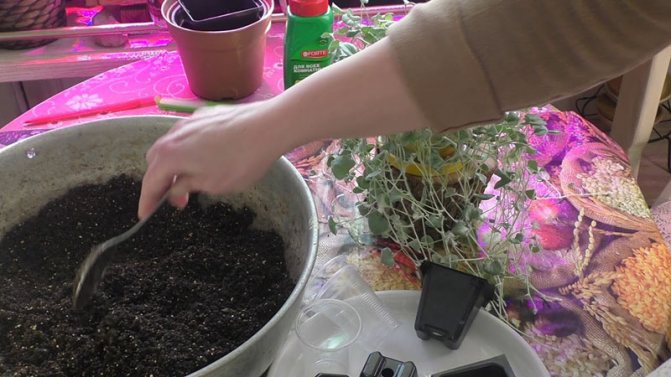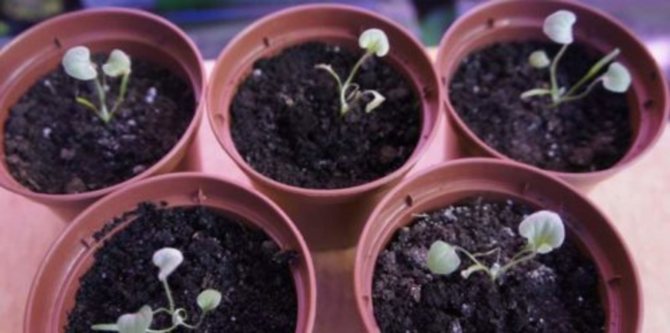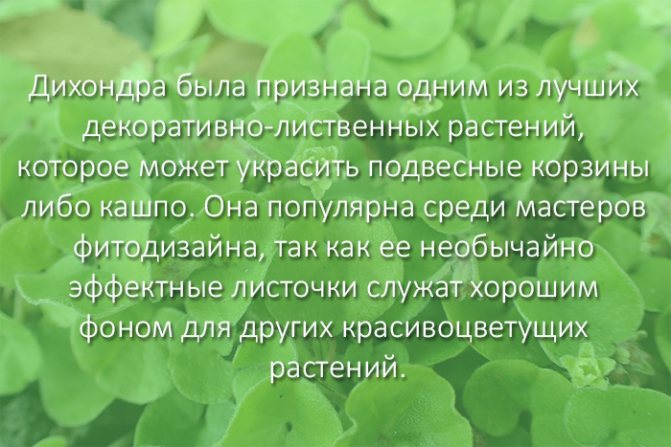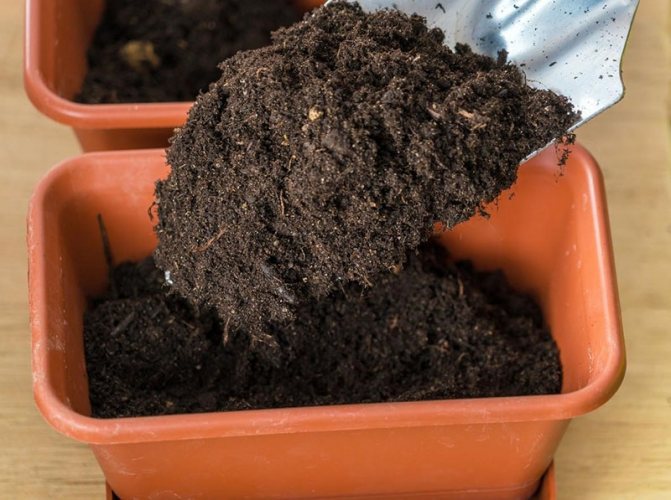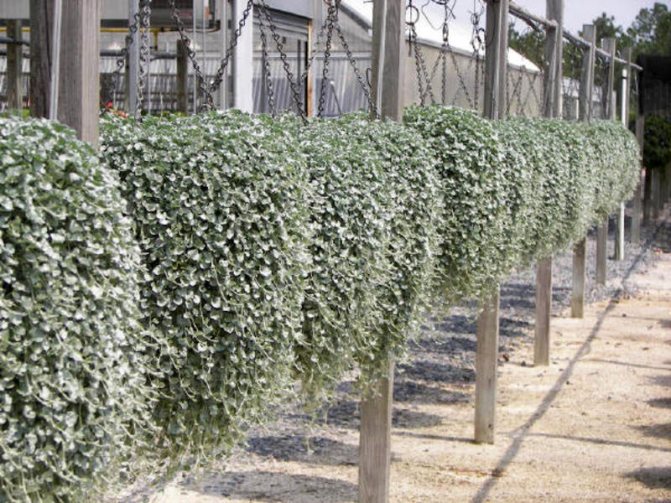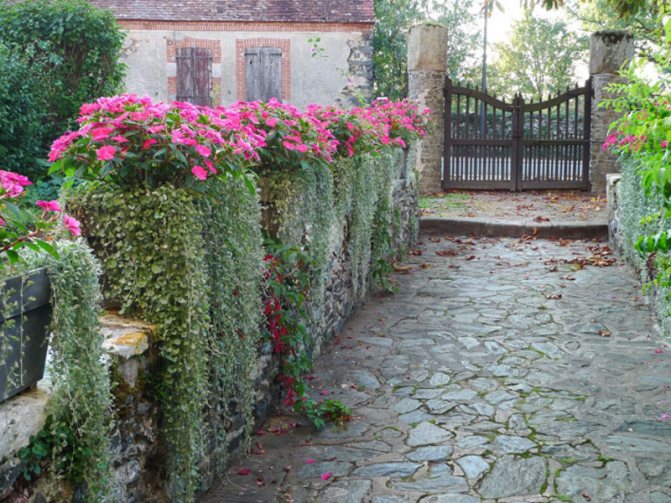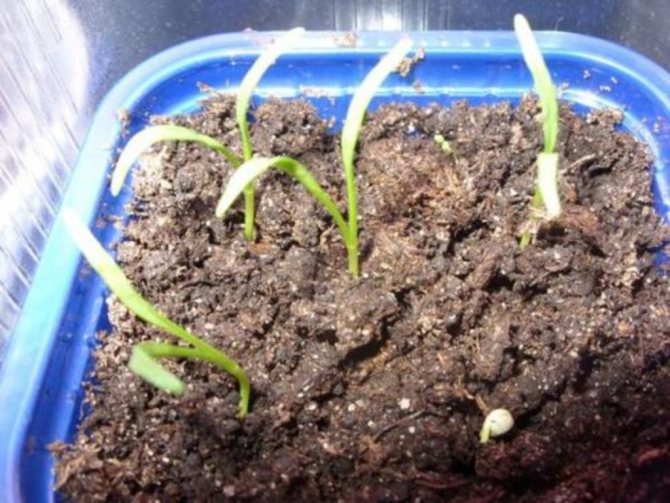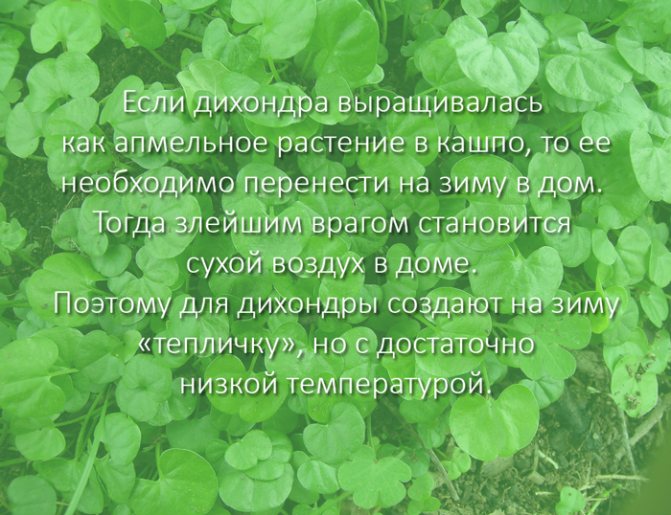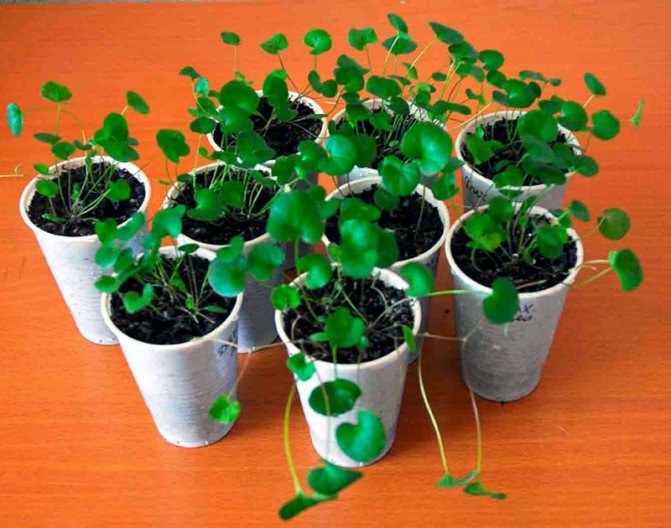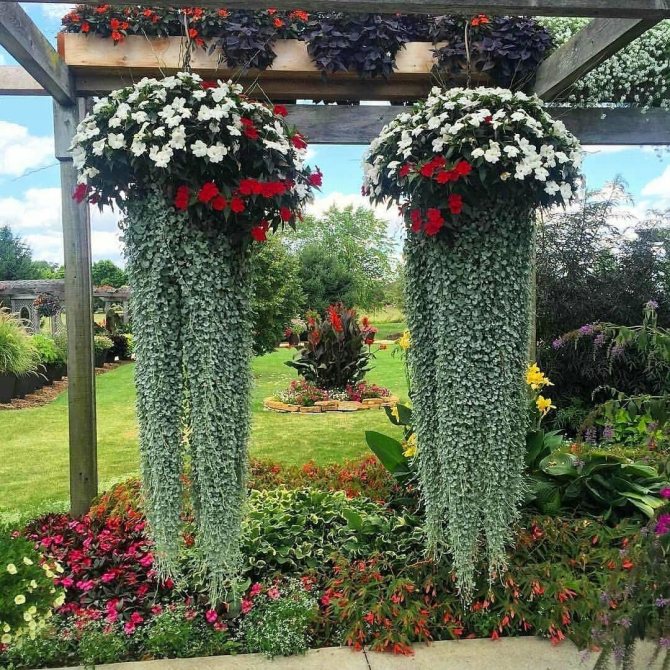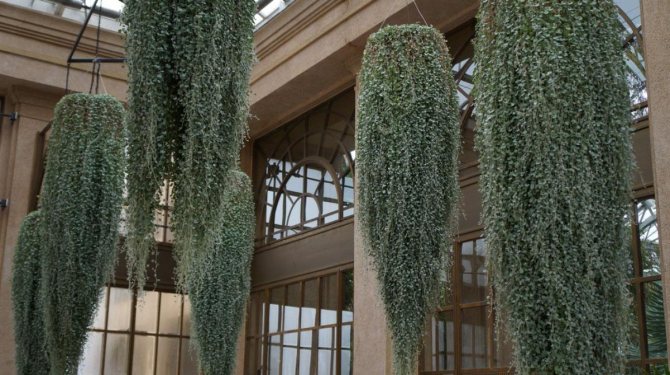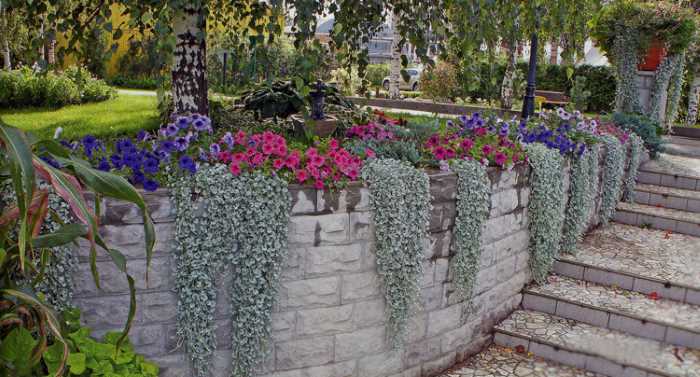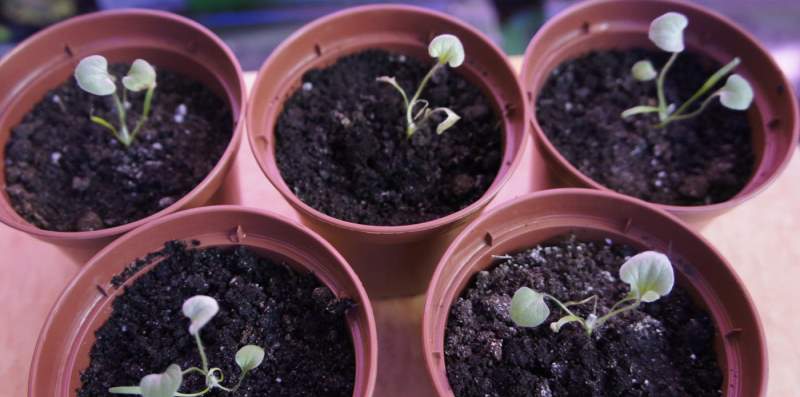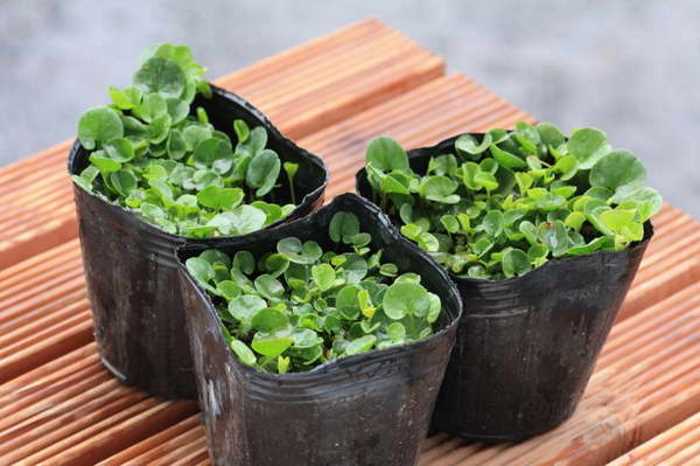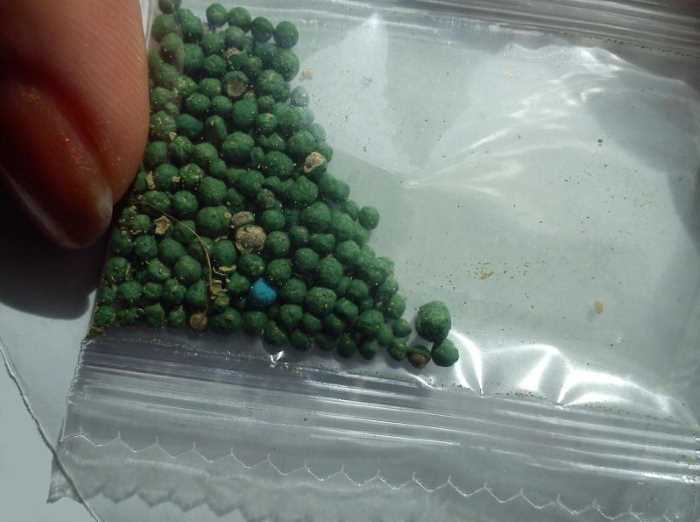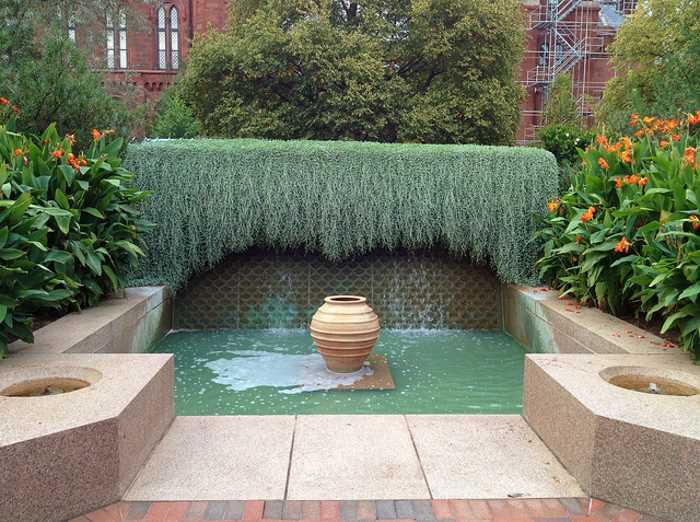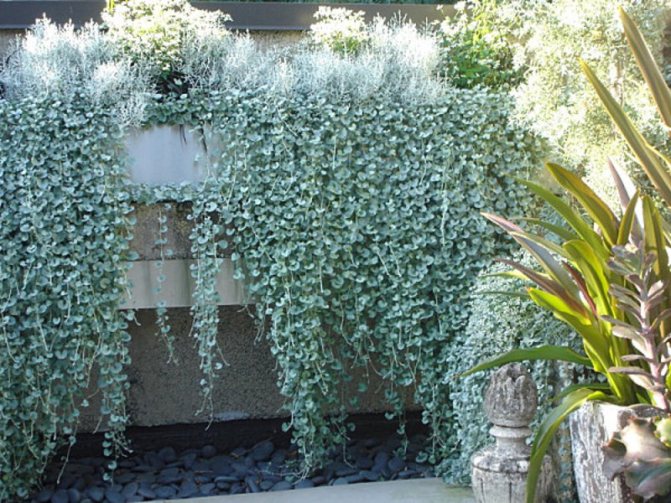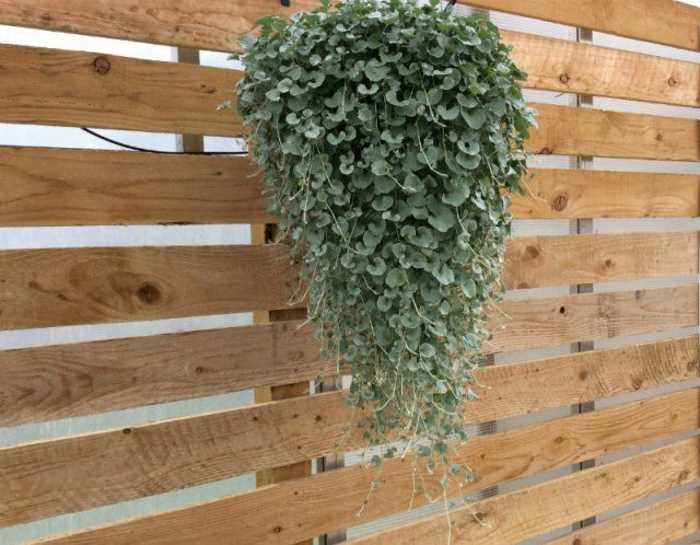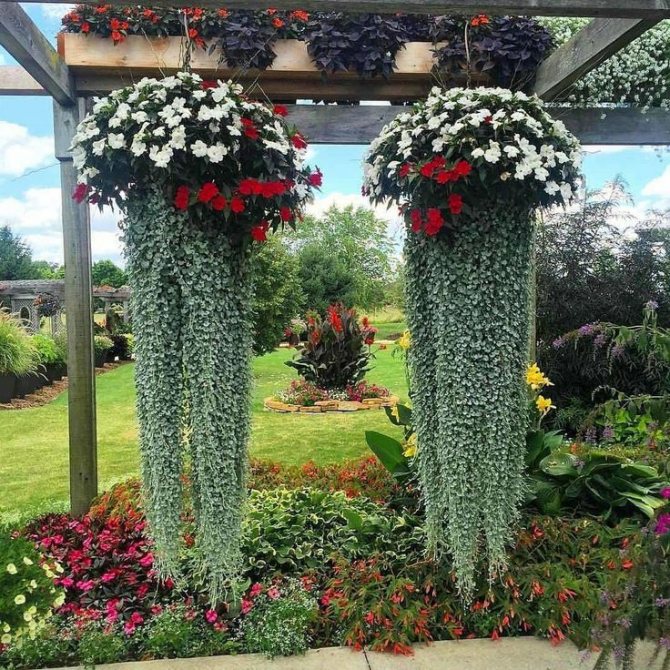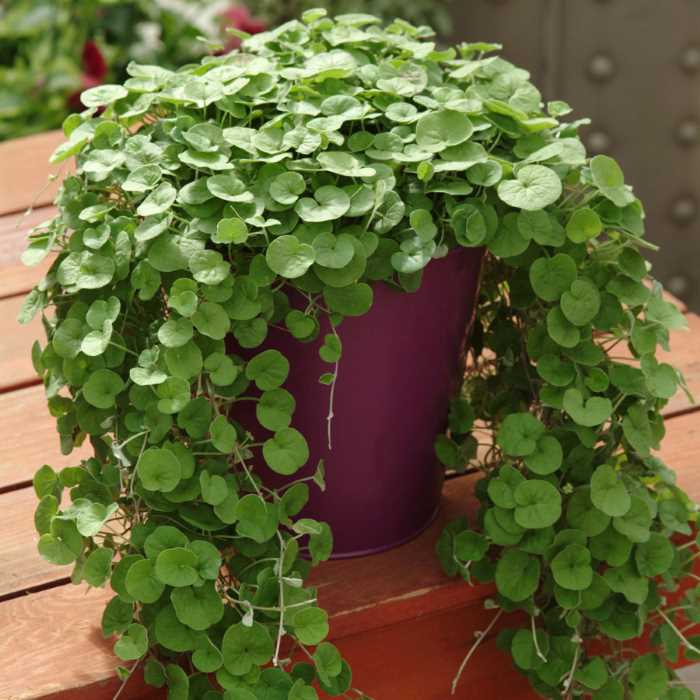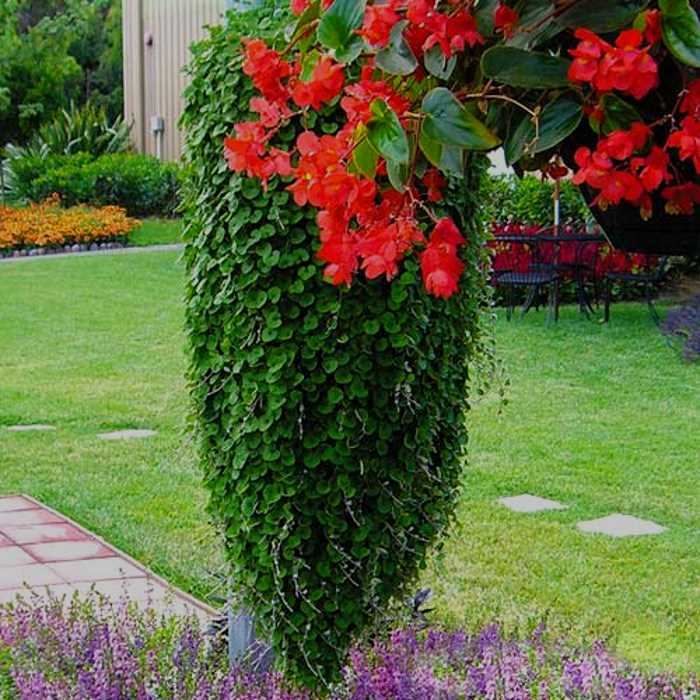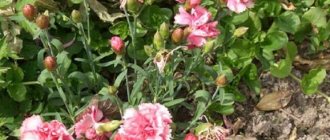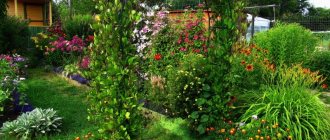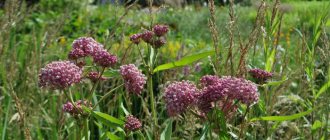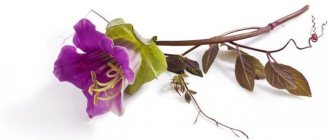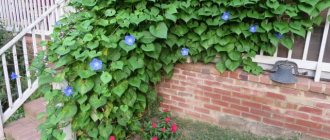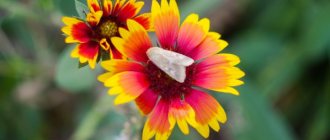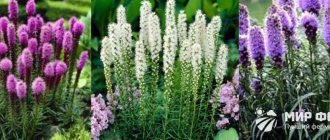Category: Garden Plants
Dichondra (lat.Dichondra) - a genus of herbaceous evergreen perennials of the Bindweed family, whose representatives are relatives of such plants as morning glory, calistegia and bindweed. The name "dichondra" consists of two Greek words that translate as "two grains" - this is due to the fact that the fruits of the plant look like a two-chamber capsule. There are 10 species in the genus that naturally grow in the humid places of the tropics and subtropics of Australia, New Zealand, East Asia and America. In floriculture, the dichondra plant has been used not so long ago, however, with its help, designers learned how to create magnificent compositions, so it is not surprising that in 2004 at an exhibition in Moscow the plant received a silver medal.
Planting and caring for dichondra
- Bloom: grown as an ornamental deciduous plant.
- Landing: sowing seeds for seedlings - in January-February, planting seedlings in open ground - from late May to mid-June.
- Lighting: bright sunlight, diffused light, partial shade and even shadow. Plants with silvery leaves are more light-requiring.
- The soil: well-drained loams with a pH of 6.6-8.0.
- Watering: regular, but moderate, in the evenings, so that there are no burns on the leaves.
- Air humidity: in heat and drought, evening spraying of the leaves is recommended.
- Top dressing: 2 times a month during the growing season with a complex mineral fertilizer with a predominance of nitrogen and potassium.
- Pinching and trimming: at the stage of development of 4 pairs of leaves, the shoots are pinched for better tillering. As the shoots grow, they are pruned once every two weeks.
- Reproduction: seed and vegetative - cuttings and layering.
- Pests: nematodes, whiteflies, aphids and fleas.
- Diseases: practically not affected.
Read more about growing dichondra below
How to care for a plant at home
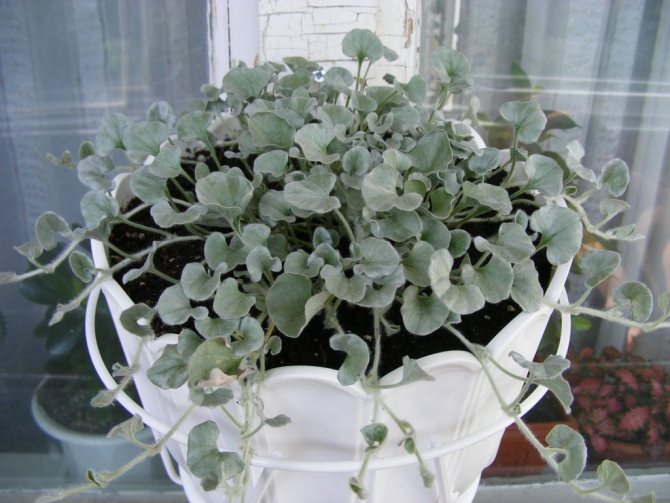
When growing dichondra in a silver house, you do not need to make excessive efforts. The process is not at all as complicated as it seems at first glance. The pot with the plant must be placed in a room with a lot of sunlight. In order for the culture to grow well, it is necessary to establish the optimal temperature regime. Good growth is observed in a room in which the temperature is above 17-degree mark. And at 9-degree temperatures, dichondra can die. Too hot room conditions also negatively affect the plant.
With daily moistening of the flower, its strong growth is observed. Greens will delight the eye. It is recommended to spray the crown twice a day. It is necessary to ensure that the earth is not excessively moistened, which will prevent the development of diseases. From autumn to early spring, the plant does not need to be fed. But during the growing season, top dressing should be applied after a 2-week period of time. Florists recommend feeding the plant with Ideal. To accelerate the growth of leaves, Agricola is added to the ground.
If you want to see the plant lush, the stems should be cut and pinched. Dichondra will become an attractive flower if you take care of it constantly. Foliage will delight with its attractiveness throughout the year.
Ampel dichondra - description
The dichondra flower is an evergreen creeping plant that forms a dense carpet on the soil surface.The root system of the dichondra is superficial. The height of the shoots is only 15 cm, but their length can reach from 1 to 1.5 m. The stems of the plant are creeping, branched, quickly rooting with the help of surface roots formed in internodes. Nondescript greenish, purple or yellowish flowers with a diameter of 2-3 mm bloom from May to August. Dichondra is pollinated by small insects. Its round, like coins, with a diameter of 0.5 to 2.5 cm, leaves very densely cover the stems.
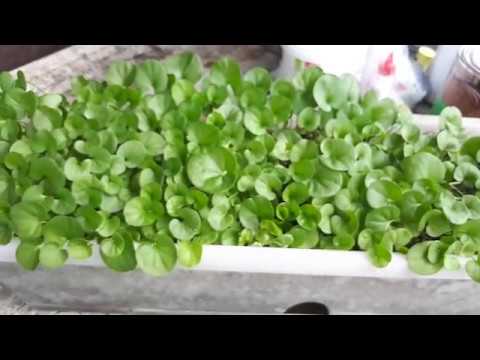

Ampel dichondra is popular in culture: in areas with cold winters it is grown as an annual plant, and in areas with warm and mild winters - as a perennial. Home dichondra spends winter indoors, and summer on a balcony or terrace. Growing dichondra is an easy and enjoyable activity, and we will tell you how to grow dichondra from seeds, how to plant and care for dichondra at home and in the garden.
Types and varieties
Dichondra silvery (Dichondra argentea) Is a species native to the desert regions of western Texas, New Mexico, southeastern Arizona, and northern Mexico. Its stunning Silver Falls variety is considered to be the most popular in landscaping gardens, balconies and terraces.
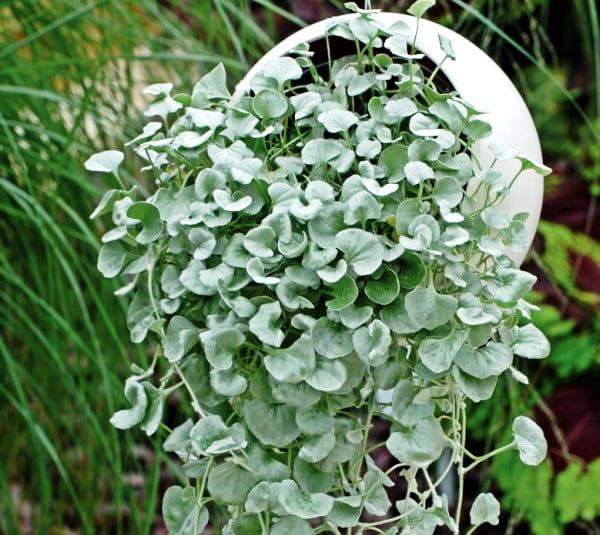

Dichondra "Silver Falls"
This fast-growing plant with branched shoots gets its name from the spectacular color of small and numerous, rounded silvery-gray leaves. Tiny greenish yellow or white spring flowers have no decorative value.
Dichondra creeping (D. repens) native to New Zealand and Australia, represented by the Emerald Falls variety. This species was very popular in California in the 1950s and 1960s as an alternative to grass turf.
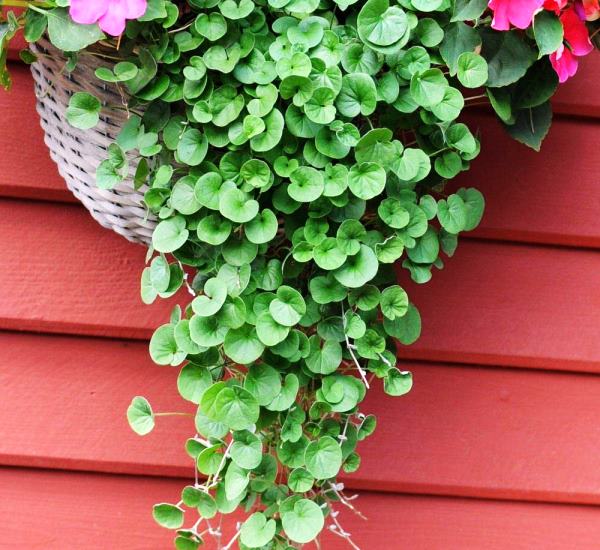

"Emerald Falls"
Dichondra leaves "Emerald Falls", in contrast to the silvery variety, are dark green and more round, like coins. Expanding, it forms a dense and resistant to trampling coating. Looks good in hanging baskets.
Both species are highly valued by gardeners for their simplicity in care, ease of reproduction and the ability to grow rapidly, however, "Silver Falls" can most often be seen in gardening.
Growing dichondra from seeds
Sowing dichondra seeds
For growing dichondra in an annual culture, both generative reproduction and vegetative propagation are used - rooting of cuttings and summer cuttings, and for primary cultivation, the seed method is used, seedling and seedling. Dichondra is sown for seedlings in the middle of winter, in January-February. Before sowing, dichondra seeds are soaked overnight in water with a growth stimulator. Sowing dichondra is carried out in a sterile soil peat substrate for seedlings, poured with sodium humate. Embedding depth no more than 8 mm. As a container, it is better to use pots in which 2-3 seeds are placed. Crops are covered with foil or glass, leaving a small hole for ventilation, and kept under diffused light at a temperature of 22-24 ºC.
- Erythronium (kandyk): growing and caring for the garden
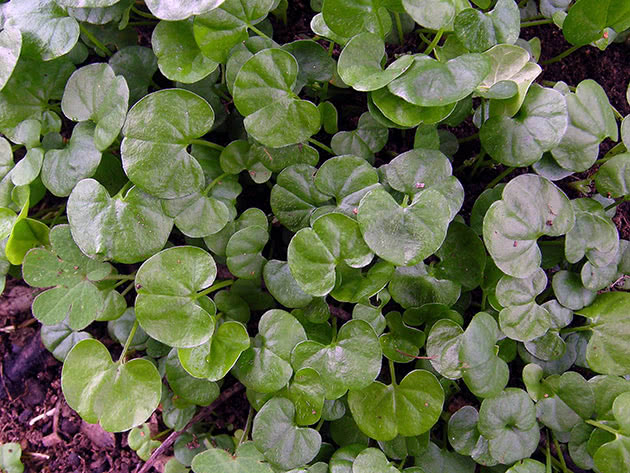

Dichondra seedling care
Under favorable conditions, the first shoots may appear within a week. Seedlings grow very slowly, but when they get stronger, the cover can be removed. Seedling care consists in regular watering and gentle loosening of the substrate. Make sure that the dichondra seedlings receive enough light, otherwise the seedlings may stretch out painfully.
From time to time, a little growth stimulant can be added to the water for watering the seedlings. At the stage of formation of 3-4 leaves in dichondra, seedlings are dived: if you are going to grow the plant as an ampel, in a pots or basket, then transplant it immediately to a permanent place, and if you expect to plant it in the garden, then dive the seedlings into large containers.Before planting in open ground, dichondra from seeds must undergo hardening procedures.
Planting dichondra in the garden
When to plant dichondra
In warm areas, dichondra is often used to form an alternative lawn due to its cold resistance and resistance to trampling. Planting ampelous dichondra in open ground is carried out one and a half to two months after the emergence of shoots. The approximate dates for planting seedlings for the southern regions is May, and for the northern ones - the beginning or mid-June.
Dichondra grows well both in the sun and in the shade, but the variety with silvery leaves is more photophilous. The plant is undemanding to the composition of the soil, but prefers loamy, well-drained soils with a pH of 6.6-8.
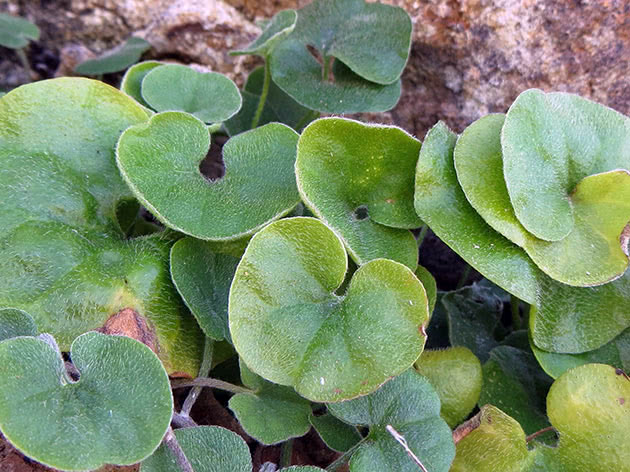

How to plant dichondra
If you want to use dichondra as a ground cover plant, keep in mind that it grows very slowly, so the seedlings need to be planted close to each other - at a distance of 10-15 cm. Make holes so deep that the seedlings will fit in them together with the earthy clod, transfer the seedlings, cover the holes with earth, compact the surface and water.
Dichondra care in the garden
Garden dichondra, subject to simple care rules, is capable of retaining decorativeness from 5 to 7 years. Despite the fact that the plant is drought-resistant, try to water it regularly, however, waterlogging of the soil is not encouraged. Try to water the groundcover dichondra in the evenings to avoid burning the leaves. And do not forget about spraying the plant in the hot season - dichondra grows well in high humidity.
- Erythronium (kandyk): growing and caring for the garden
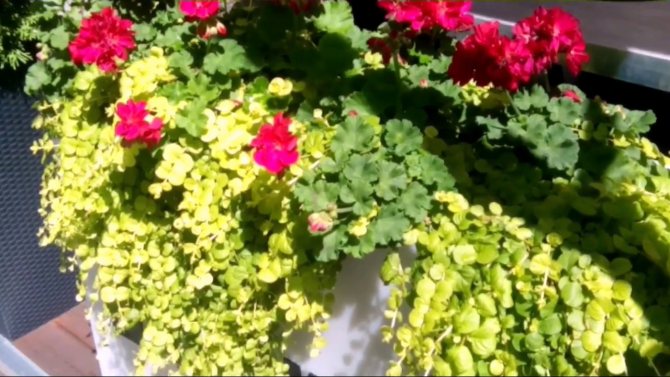

To achieve a high level of decorativeness of dichondra, it is necessary to apply a complex mineral fertilizer with a predominance of potassium and nitrogen to the soil twice a month during the growing season.
After the appearance of eight leaves, it is advisable to pinch the dichondra stems, and in the future, as it grows and branching, the plant should be pruned - usually during the summer, one haircut in two weeks is enough.
Weed control requires caution, since it is very easy to damage the roots of dichondra, which are located at a shallow depth.
How to deal with diseases and pests


Growing silver dichondra and its other varieties will not cause any special problems. The plant is highly resistant to various diseases. Harm is possible only from nematodes, which are microscopic worms. They can appear on too moist areas. Plants mutate and even die under the influence of worms.
The appearance of nematodes can be seen on crops growing on the site and in a pot. You cannot eliminate worms. At the first detection of nematodes, it is recommended to get rid not only of the bush, but also of the land on which the plant grew. Then the place is disinfected with various special preparations.
Sometimes dichondra can be exposed to other insect pests as well. A whitefly, flea or aphid can take a fancy to it. The fight against them is carried out by various special preparations of an acaricidal nature. To prevent insects from appearing, it is recommended:
- Do not water frequently if the plants are growing in moist soil. Also, do not over-water those areas where the bushes have turned into a dense carpet.
- The land around the plants cannot be mulched, and the weeds must be pulled out manually so as not to damage the root system.
- Plant bushes in areas that are not rich in nitrogen.
Dichondra care at home
How to care for dichondra at home
Caring for dichondra at home is simple, as is caring for other decorative leafy ampels - chlorophytum, creeping ficus, rooting ficus, asparagus, saxifrage or zebrin, but before growing dichondra at home, you need to study its botanical features and preferences ... The level of illumination for dichondra is determined by the color of its leaves: for plants with a green color, both brightly lit places and partial shade, and even a shadow, are suitable, and silver-leaved dichondra are more photophilous and will not grow in the shade.The temperature regime requires a level of 18-25 ºC at any time of the year, but if dichondra is in an unheated room in winter, the temperature in it should not fall below 10 ºC, otherwise the plant may die. Dichondra grows poorly in conditions of constantly high temperature.
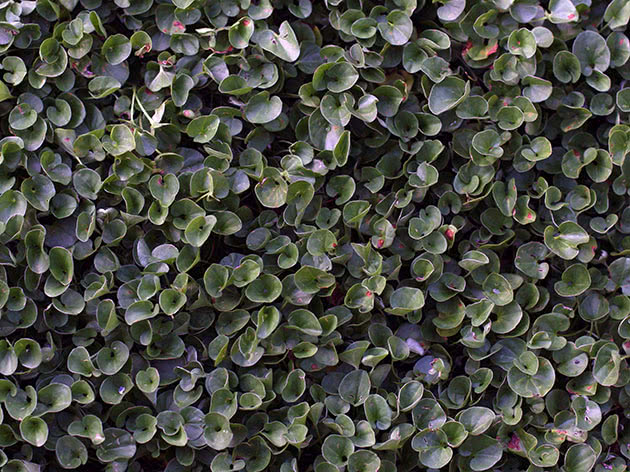

Dichondra can grow at low air humidity, but daily spraying will benefit it - the growth of green mass will increase by 25%. If you spray dichondra twice a day (morning and evening), the process of deciduous mass formation will be accelerated twice. Dichondra especially needs spraying during the winter months if it overwinters at temperatures above 18 ºC.
As for watering, it should be abundant, however, the plant does not tolerate stagnation of moisture in the roots, so there should be a thick layer of drainage material in the pot. If there is a long break between watering, and the substrate in the pot with the plant dries up, dichondra can live for some time without water, and after watering it will quickly recover.
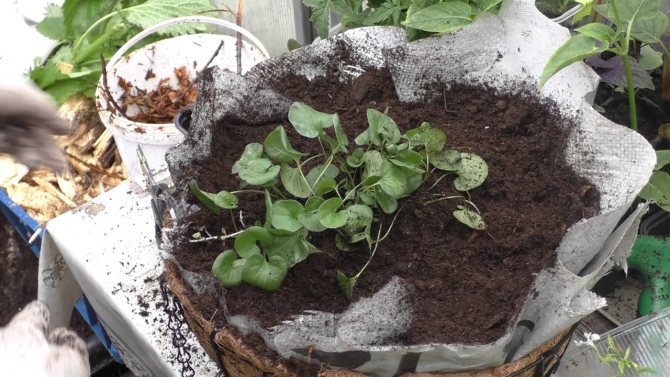

Twice a month from April to September, fertilizer for decorative deciduous indoor plants, for example, Ideal, should be applied under dichondra. In addition, dichondra Agricola can be fed once a week to speed up the formation of deciduous mass. In winter, if the plant is in a cool room, it does not need feeding.
- Erythronium (kandyk): growing and caring for the garden
Pruning dichondra
To form a lush crown at the ampelous dichondra, it must be pinched and trimmed. The plant needs pruning and preparation for wintering. To enhance tillering, the ends of the shoots are pinched, and when they become too long, they are cut off. In culture, dichondra lashes can reach a length of two meters, and in warm climates they grow up to six. Landscape designers use dichondra to create an imitation of a running stream in the garden - it looks spectacular, especially since the falling stems, reaching the ground, easily root, turning the ampelous plant into a ground cover. Trimming the dichondra lashes or letting them grow is up to you, but pinching the ends of the shoots to enhance bushiness is still desirable.
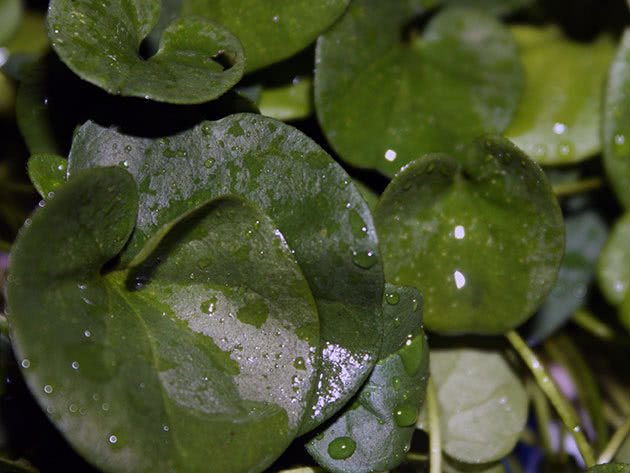

Dichondra placement
Dichondra grows equally well in the garden and in indoor culture. The superficial roots formed in the internodes of the stems take root easily, forming a solid green or silvery carpet that does not lose its color even in winter. And the dichondra, grown as an ampel, flows down a silvery or green waterfall. Pots or baskets with dichondra decorate dwellings, terraces, verandas, balconies and loggias.
Pests and diseases of dichondra
Dichondra is resistant to any diseases and harmful insects, since in essence it is a weed, and if you follow the conditions for keeping it, then nothing will harm the health of the plant. The only danger that can threaten dichondra is nematodes - microscopic worms that develop in a humid environment, causing mutations that lead to the death of the plant. Moreover, nematodes are affected by both garden and indoor crops. It is useless to fight them, so it is better to immediately destroy the plants and the soil in which they grew.
In addition to nematodes, in rare cases, whiteflies, aphids and fleas can disturb dichondra. They destroy these pests with acaricides, and so that these problems do not arise, you can use the following preventive measures:
- do not mulch the area where the dichondra grows, but remove the weeds by hand;
- if the planting of dichondra has turned into a dense carpet, reduce the number of waterings;
- do not exceed a reasonable dose of nitrogen fertilizers.
What problems can you face
Dichondra is resistant to insect attacks and diseases. Careful care, compliance with the conditions of detention, reduce the likelihood of illness to a minimum. Sometimes growers have to deal with a nematode - microscopic worms.They develop in conditions of high soil and air humidity. Growth is inhibited, the plant gradually dies. Pot and horticultural crops are affected by nematodes. Pest control is useless. In the initial stages of the disease, cuttings are cut and rooted. The rest of the plant is destroyed along with the soil and pot.
Less often you have to deal with aphids, fleas and whiteflies. Pests disappear after treating the flower with insecticides. After trimming the damaged lashes that have lost their decorative effect, the volume quickly returns.
Dichondra will appeal to everyone who loves ampelous plants. Its long lashes covered with small leaves really resemble a waterfall.
Reproduction of dichondra
As already mentioned, in addition to the seed method for reproduction of dichondra, vegetative ones are also used - cuttings and rooting of cuttings, and these methods are much easier and more effective to perform than generative reproduction. After the pinching and autumn pruning of the lashes, the stem apical segments remain - cuttings that take root easily. In winter, they will grow on your windowsill, and in the spring they can be planted in a permanent place.
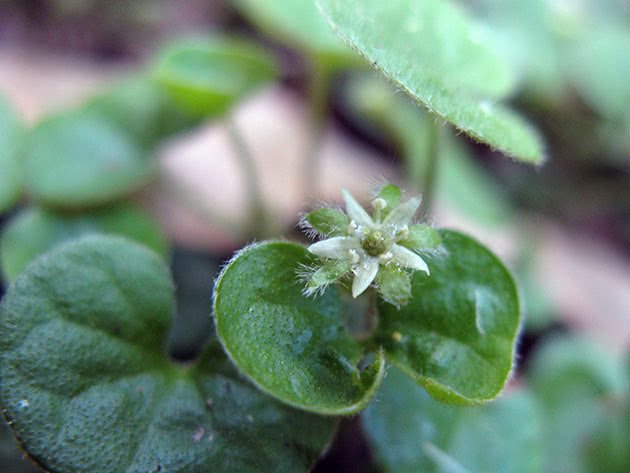

As for the reproduction of dichondra by layering, then you don't have to put any effort into it: the stems of the plant have additional roots, which themselves grow into the soil, rooting the stem. This stem can be detached and transplanted at any time.
Perennial dichondra in winter
In areas with warm winters, the dichondra is left to winter in the garden, covering it with earth, covering it with a film, and throwing fallen leaves over the film. Where there is frost in winter, perennial dichondra is transferred to a greenhouse with tropical or subtropical plants or indoors - on a closed veranda, on a glazed balcony or loggia. The plant is kept in a bright, cool place where the temperature is kept between 11-15 ºC. Watering dichondra is greatly reduced, and feeding is stopped altogether. The garden dichondra is dug up and, together with an earthen lump, is placed in the basement, where it will remain in suspended animation until spring. At the beginning of the next vegetative period, shoots with root suckers should be cut off from the mother liquor, and the root system should be planted in open ground.
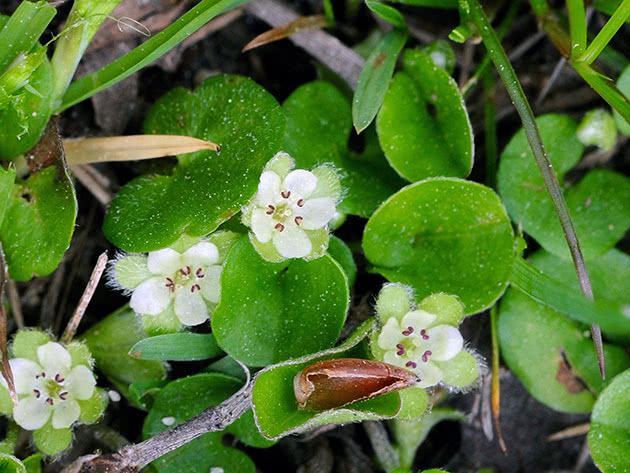

Combination with other plants in decorating the site
With the help of dichondra, which grows in the open field, you can make many eye-pleasing combinations:
- cover the surface of the earth;
- decorate the gazebo and any other object in the garden with greenery;
- a kind of silver waterfall looks great on the rocky surface of the alpine slides, creating the sensation of flowing water in the sun.
A dichondra carpet will accentuate the shade of bright colors: petunias, dahlias, bindweed. This combination will look beautiful in family photos.
Dichondra is an excellent tool for creating a unique landscape on the site. But remember that the plant will tend to overgrow and may oppress weaker crops.

